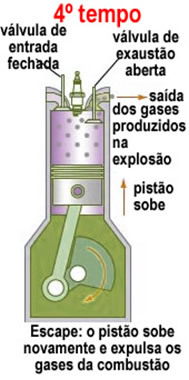The engine that usually equips cars is the four-stroke combustion or combustion engine. It is called that because its functioning is based on exactly four different stages or times. See each of them:
1st Stage: at this stage, the engine piston moves down and pulls the mixture of fuel (steam) and atmospheric air through the inlet valve.

2nd Stage: after the combustion chamber has been filled, the inlet valve for the mixture of air and fuel vapor is closed and the piston rises, compressing this mixture.

It is very important that the fuel withstand this compression well, not exploding before the 3rd time. If the fuel prematurely explodes during compression, it will decrease engine power and produce a noise known as pin hit (knocking). Higher octane gasolines are better because of this: the higher the octane index, the more resistant the gasoline will be to the compression suffered and the better the performance of the engine.
Do not stop now... There's more after the advertising ;)
That's also why they add antiknocks to gasoline, such as ethanol.
3rd Stage: when the piston reaches its maximum point, the spark plug emits an electrical spark that causes the explosion, displacing the piston downwards. The kinetic energy of the expanding gases is transmitted to the piston, which moves the crankshaft shaft, causing the car to move.
This part is very important, as it is here that chemical energy (from combustion) is transformed into mechanical energy (which will move the car).

An image of the spark produced by the spark plug is shown below:

4th Stage: the piston rises again and the exhaust or outlet valve is opened, allowing the gases formed in combustion to be released. When this valve closes, the inlet valve is opened and the process starts over.

By Jennifer Fogaça
Graduated in Chemistry
Would you like to reference this text in a school or academic work? Look:
FOGAÇA, Jennifer Rocha Vargas. "Combustion Engine Operation"; Brazil School. Available in: https://brasilescola.uol.com.br/quimica/funcionamento-motor-combustao.htm. Accessed on June 27, 2021.



